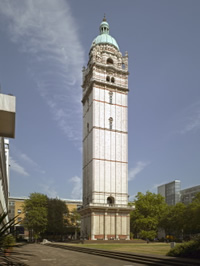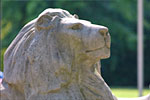John Hone
(Physics 1950)
John Hone tells a tale of the magnificent Queen's Tower at Imperial College's South Kensington campus.
 The Queenís Tower stands in the campus of Imperial College in splendid isolation. It was not always thus.
The Queenís Tower stands in the campus of Imperial College in splendid isolation. It was not always thus.
Sixty years ago it formed the central feature of the Imperial Institute Museum which stretched alongside the north side of Imperial College Road (then called Imperial Institute Road). The Museum housed a selection of artefacts from the British Empire, then in its final days. Virtually deserted for much of the time it occasionally entertained the odd party of school children who were unfortunate enough to be compelled to visit.
It formed a barrier between the Royal College of Science on the south side of the road and the Imperial College Union in Prince Consort Road. There was, however, a way through. This involved entering the Museum, descending to its nether regions and negotiating dimly lit passages filled with mysterious objects and central heating pipes which gave a headroom of about five feet. Eventually one reached a staircase back up to ground level and gained access to a road past the Rectorís lawn and thence the Union. The continuous stream of students making this trip probably far outnumbered visitors to the Museum.
Access to the Tower was via a small, unmarked, insignificant door on the first floor of the Museum. Needless to say it was always locked except on one occasion when a passing student noted it ajar. Such an opportunity was not to be missed and the student, unobserved, entered the Tower and climbed the staircase to the first level which forms the base of the dome. After examining the bells, he noticed a flight of wooden stairs leading to the top of the dome. Ascending these he arrived at a door which gave access to the small gallery with parapet surrounding the base of the cupola perched on top of the dome.
The gallery was quite narrow and its parapet prevented the door from opening very far. Pushing it open as far as possible our student passed through on to the gallery and was rewarded with a panoramic view of London as it was just after WWII. To the west he could see the Lotts Road Power Station in Chelsea and Battersea to the south, going full blast with the Surrey hills in the background. Eastwards Big Ben and St Paulís dominated the skyline with the Monument beyond. In the north he looked on the Albert Hall and Hyde Park with Hampstead in the distance. There were no other high-rise structures at the time so he enjoyed a unique view from this vantage point.
Having made a circuit of the cupola the student arrived back to face the outer side of the open door with its far edge up against the parapet. To get past he pushed the door closed. Too late he discovered to his horror that there was no handle on the outside. The door was shut and there was no way of opening it. Presumably the builders of the Tower had not expected anyone to arrive at the door from the outside (except perhaps an unlucky parachutist) and had seen no necessity of providing an exterior handle. Whatever the reason, our student was trapped.
His predicament was too horrible to contemplate. No one knew his whereabouts. The museum staff would lock the access door below and had no reason to suppose that anyone was marooned above. Presumably, in time, he would be missed and a search initiated, but would anyone think of looking for him hundreds of feet above the South Kensington streets. It could be weeks before anyone else came up there. He looked over the parapet and briefly considered sliding down the roof of the dome and perhaps gaining access to the lower level. He abandoned that perilous idea fairly soon for obvious reasons. He could shout for help but, at that time, Imperial College Road was a through route and it was doubtful that his cries would be heard above the noise of the traffic. Possibly late at night someone might hear him but the poor student could hardly bear to think of the humiliation. He would never live it down. Moreover, Authority and the College were bound to take a pretty severe view of his escapade. Perhaps sliding down the dome was not such a bad idea after all!
The end of the story is quite tame. He did not know whether or not the door had a latch. If so, it was frighteningly close to being engaged. Fortunately the door did not hang exactly true and, at its lower edge, a bare millimetre or two projected proud from the opening. A tremulous fingernail engaged this slim chance of escape and, with infinite care to ensure that any latch did not engage, the door was gently eased open. A shaken and very relieved student descended the stairs and returned to his studies.
Some weeks later the same student again noticed an open entrance to the Tower and repeated his climb to the top. This time however, he jammed the door open, using one of the duck boards lining the floor of the gallery. He also scratched his initials, College (RCS) and the date (1947) onto the cupola, using his penknife. I wonder if they are still there.
Occasionally the College organises trips to the top of the Tower. Iíve never really been tempted to join any such trip to find out if the marks remain. And besides, Iíve been there. Twice.
John G E Hone ARCS (Physics 1950)
© 2007 Imperial College London

Through the first decade of the twenty-first century the campaign seeks to philanthropically raise £207 million from Imperial’s alumni, staff and friends, and donations from charitable foundations and industry.
Where your support can make a differenceGive now

Imperial’s Centenary Year provides an opportunity to recognise and celebrate members of the Imperial community.
View staff and student portraits
